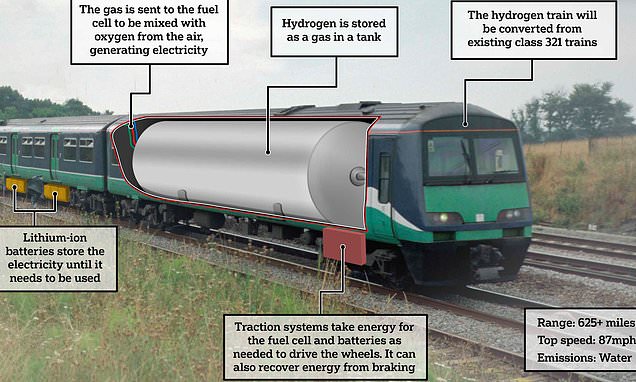Steam trains conjure up nostalgic images of the golden age of rail travel.
But are these iconic locomotives actually good for the planet?
Let’s take a closer look at the environmental impact of steam engines.
Are Steam Trains Environmentally Friendly?

Traditional coal-fired steam trains were not very environmentally friendly due to the emissions produced from burning coal.
However, modern steam locomotives can implement cleaner fuels and new technologies to reduce their environmental impact.
Using renewable fuels like waste vegetable oil can make steam train operations much more eco-friendly.
Key Points
- Coal-fired steam trains produced significant air pollution and greenhouse gas emissions.
- Modern steam trains can use cleaner-burning renewable fuels like waste vegetable oil.
- With sustainable practices, steam trains can be an environmentally friendly transport option.
Our Opinion
While old coal-fired steam locomotives did have negative environmental impacts, I believe steam train operations can be made much more eco-friendly with modern innovations.
Using renewable fuels and implementing energy-efficient technologies allows steam trains to provide nostalgic, romantic journeys while minimizing their carbon footprint.
With sustainable practices, steam trains do not have to be at odds with environmental values.
Are Steam Trains More Eco-Friendly Than Other Transport?
When it comes to eco-friendliness, steam trains have a mixed record:
- Burning coal to power steam locomotives releases significant carbon emissions and air pollutants like soot and ash.
- However, some railways have transitioned to burning renewable biofuels like e85 and waste vegetable oil in their steam engines. This greatly reduces net carbon emissions.
- Steam engines are less efficient than modern diesel or electric trains due to energy losses in steam generation. But on scenic and heritage routes, their appeal makes up for this.
- While not as clean as electric trains, steam locomotives with updated emissions controls release far less pollution than gas-guzzling cars and trucks.
So while nostalgic steam trains may not be the greenest transport option, railways can take steps to reduce their environmental impact. Using renewable fuels, installing emissions controls, and focusing steam engine use on heritage routes helps maximize sustainability.
At the end of the day, well-maintained steam locomotives still pollute less per passenger mile than most cars. For scenic and historic routes, their old-fashioned appeal makes steam trains a transport option worth retaining.
What Fuels Do Steam Locomotives Use?

Steam locomotives traditionally burned coal to heat water and produce steam. However, today there are cleaner options:
- Some railways now use renewable biofuels like waste vegetable oil. This produces less net carbon emissions.
- Natural gas is another cleaner-burning fuel used to fire some steam locomotive boilers.
- A few pioneering railways even experimented with powering steam engines using solar thermal energy. This involves focusing sunlight to heat water.
Coal was once the default fuel for steam trains. But modern railways are transitioning to less polluting alternatives. Biofuels, natural gas and even solar power allow steam engines to run with a smaller carbon footprint.
This shows heritage railways can balance tradition with innovation. With creativity, steam locomotives don’t have to be left behind in the push for cleaner transportation.
How Efficient Are Steam Trains Compared to Diesel or Electric Trains?
When it comes to energy efficiency, steam locomotives are at a disadvantage compared to modern diesel and electric trains.
A steam engine only converts about 5-10% of its fuel’s energy into motion. The rest is lost as waste heat and smoke up the chimney. This inherent inefficiency is why steam engines were phased out by the mid-20th century.
By contrast, a diesel locomotive can convert over 40% of its fuel into usable power. Electric trains are even more efficient, with losses as low as 15%.
However, steam enthusiasts argue efficiency isn’t everything. The ambience and nostalgia of a steam train are worth the extra fuel cost to some. They also point out that steam engines can be run on renewable biomass, helping offset their carbon footprint.
While outmoded, steam locomotives retain a devoted following. Their energy inefficiency is accepted as part of their charm. With sustainable fuels, steam power can still have a place on modern railways.
Can Steam Trains Be Modified to Reduce Emissions?

Yes, there are some modifications that can help reduce the emissions from steam locomotives.
One option is to install devices like mechanical stokers, which feed coal more efficiently into the firebox. This improves combustion and decreases smoke.
Switching to cleaner-burning fuels like wood pellets can also lower emissions. Wood emits less soot and fewer particulates than coal when burned.
Retrofitting oil- or gas-fired burners enables some steam engines to switch away from coal entirely. This eliminates the clouds of black smoke that gave steam its dirty reputation.
For smokestack exhaust, emissions can be reduced by passing the gases through filtering systems. Cyclone separators can capture over 85% of particulates.
While they will never be as clean as electric or diesel, upgraded steam locomotives can certainly be made less polluting. With some clever engineering, their nostalgic appeal doesn’t have to come at the cost of high emissions.
Are There Any Sustainable Steam Train Initiatives?
Yes, there are a few noteworthy initiatives aiming to make steam train travel more sustainable.
One example is the project by Swiss locomotive manufacturer Dampflokomotiv- und Maschinenfabrik DLM AG to convert coal-fired steam engines to run on biogas. This renewable fuel emits far fewer particulates and greenhouse gases.
In the UK, the Ribble Steam Railway has been experimenting with a steam locomotive fueled by waste vegetable oil. Though not completely emission-free, it’s a creative way to repurpose waste into sustainable steam power.
Some railway preservation societies like the Severn Valley Railway in England have installed heat recovery systems on their steam engines. This captures waste heat to warm water, reducing overall energy loss.
While they may not be as green as electric trains yet, initiatives like these show the potential for steam locomotives to move towards more sustainable operations. With some innovation and investment, steam power may have a cleaner future.
FAQ
Were Steam Trains Good for the Environment?
Steam trains were not particularly good for the environment as they burned coal, which released emissions that polluted the air. The steam engines also were not very energy efficient.
Is Steam Locomotive Bad for the Environment?
Yes, traditional coal-fired steam locomotives did have some negative environmental impacts due to the emissions from burning coal. This included air pollution and greenhouse gas emissions.
How Polluting Are Steam Locomotives?
Coal-fired steam locomotives released significant amounts of air pollutants, including smoke, soot, and ash. They also emitted greenhouse gases like carbon dioxide. However, they did not release as much pollution per passenger as automobiles.
What Is the Carbon Footprint of a Steam Train?
The carbon footprint of a traditional coal-fired steam train is relatively high due to the emissions from burning coal. However, the carbon footprint per passenger is lower than driving an automobile. Some modern steam trains have implemented cleaner-burning fuels to reduce emissions.
Conclusion
While steam locomotives are iconic and nostalgic, the traditional coal-fired steam trains did have some negative environmental impacts due to the emissions produced from burning coal. However, modern innovations and new fuels have helped make steam train operations more environmentally friendly. Overall, steam trains can be an eco-friendly mode of transport if sustainably sourced fuels are used.
